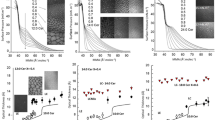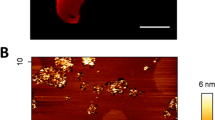Abstract
Changes of the initial composition and topography of mixed monolayers of Sphingomyelin and Ceramide modulate the degradation of Sphingomyelin by Bacillus cereus Sphingomyelinase. The presence of initial lateral phase boundary due to coexisting condensed and expanded phase domains favors the precatalytic steps of the reaction. The amount and quality of the domain lateral interface, defined by the type of boundary undulation, appears as a modulatory supramolecular code which regulates the catalytic efficiency of the enzyme. The long range domain lattice structuring is determined by the Sphingomyelinase activity.




Similar content being viewed by others
Abbreviations
- SMase:
-
Sphingomyelinase
- Cer:
-
Ceramide
- SM:
-
Sphingomyelin
- Pm:
-
Palmitic Acid
- dlPC:
-
Dilauroylphosphatidylcholine
- DiIC12:
-
1,1’didodecyl-3,3,3′,3′–tetramethylindocarbocyanine
- LE:
-
liquid expanded phase
- LC:
-
liquid condensed phase
References
Goni, F. M., & Alonso, A. (2002). Sphingomyelinases: enzymology and membrane activity. FEBS Letters, 531, 38–46.
Fujii, S., Itoh, H., Yoshida, A., Higashi, S., Ikezawa, H., & Ikeda, K. (2005). Activation of sphingomyelinase from Bacillus cereus by Zn2+ hitherto accepted as a strong inhibitor. Archives of Biochemistry and Biophysics, 436, 227–36.
Tomita, M., Taguchi, R., & Ikezawa H. (1991). Sphingomyelinase of Bacillus cereus as a bacterial hemolysin. Journal of Toxicology: Toxin Reviews, 10, 169–207.
Kronke, M. (1999). Biophysics of ceramide signaling: interaction with proteins and phase transition of membranes. Chemistry and Physics of Lipids, 101, 109–21.
Hannun, Y. A., & Luberto, C. (2000). Ceramide in the eukaryotic stress response. Trends in Cell Biology, 10, 73–80.
Maggio, B., Carrer, D. C., Fanani, M. L., Oliveira, R. G., & Rosetti, C. M. (2004). Interfacial behavior of glycosphingolipids and related sphingolipids Curr. Opinions in Colloid Interface Science, 8, 448–458.
Goni, F. M., & Alonso, A. (2006). Biophysics of sphingolipids I. Membrane properties of sphingosine, ceramides and other simple sphingolipids. Biochimica Et Biophysica Acta, 1758, 1902–21.
Fanani, M. L., Hartel, S., Oliveira, R. G., & Maggio, B. (2002). Bidirectional control of sphingomyelinase activity and surface topography in lipid monolayers. Biophysical Journal, 83, 3416–24.
Morita, S. Y., Nakano, M., Sakurai, A., Deharu, Y., Vertut-Doi, A., & Handa, T. (2005). Formation of ceramide-enriched domains in lipid particles enhances the binding of apolipoprotein. E FEBS Letters, 579, 1759–64.
Kinnunen, P. K., Koiv, A., Lehtonen, J. Y. A., Rytomaa, M., & Mustonen, P. (1994). Lipid dynamic and peripheral interactions of proteins with membranes surfaces. Chemistry and Physics of Lipids, 73, 181–207.
Boguslavsky, V., Rebecchi, M., Morris, A. J., Jhon, D. Y., Rhee, S. G., & McLaughlin, S. (1994). Effect of monolayer surface pressure on the activities of phosphoinositide-specific phospholipase C-beta 1, -gamma 1, and -delta 1. Biochemistry, 33, 3032–7.
Maggio, B. (1996). Control by ganglioside GD1a of phospholipase A2 activity through modulation of the lamellar-hexagonal (HII) phase transition. Molecular Membrane Biology, 13, 109–12.
Maggio, B. (1999). Modulation of phospholipase A2 by electrostatic fields and dipole potential of glycosphingolipids in monolayers. Journal of Lipid Research, 40, 930–9.
Ahyayauch, H., Villar, A. V., Alonso, A., & Goni, F. M. (2005). Modulation of PI-specific phospholipase C by membrane curvature and molecular order. Biochemistry, 44, 11592–600.
Ruiz-Arguello, M. B., Veiga, M. P., Arrondo, J. L., Goni, F. M., & Alonso, A. (2002). Sphingomyelinase cleavage of sphingomyelin in pure and mixed lipid membranes. Influence of the physical state of the sphingolipid. Chemistry and Physics of Lipids, 114, 11–20.
Volwerk, J. J., Filthuth, E., Griffith, O. H., & Jain, M. K. (1994). Phosphatidylinositol-specific phospholipase C from Bacillus cereus at the lipid-water interface: interfacial binding, catalysis, and activation. Biochemistry, 33, 3464–74.
Fanani, M. L., & Maggio, B. (1997). Mutual modulation of sphingomyelinase and phospholipase A2 activities against mixed lipid monolayers by their lipid intermediates and glycosphingolipids. Molecular Membrane Biology, 14, 25–9.
Fanani, M. L., & Maggio, B. (1998). Surface pressure-dependent cross-modulation of sphingomyelinase and phospholipase A2 in monolayers. Lipids, 33, 1079–87.
Jungner, M., Ohvo, H., & Slotte, J. P. (1997). Interfacial regulation of bacterial sphingomyelinase activity. Biochimica Et Biophysica Acta, 1344, 230–240.
Fanani, M. L., & Maggio, B. (2000). Kinetic steps for the hydrolysis of sphingomyelin by bacillus cereus sphingomyelinase in lipid monolayers. Journal of Lipid Research, 41, 1832–40.
Bianco, I. D., Fidelio, G. D., & Maggio, B. (1989). Modulation of phospholipase A2 activity by neutral and anionic glycosphingolipids in monolayers. Biochemical Journal, 258, 95–9.
Bianco, I. D., Fidelio, G. D., & Maggio, B. (1990). Effect of sulfatide and gangliosides on phospholipase C and phospholipase A2 activity. A monolayer study. Biochimica Et Biophysica Acta, 1026, 179–85.
Ransac, S., Moreau, H., Riviere, C., & Verger, R. (1991). Monolayer techniques for studying phospholipase kinetics. Methods in Enzymology, 197, 49–65.
Grainger, D. W., Reichert, A., Ringsdorf, H., & Salesse, C. (1990). Hydrolytic action of phospholipase A2 in monolayers in the phase transition region: direct observation of enzyme domain formation using fluorescence microscopy. Biochimica Et Biophysica Acta, 1023, 365–79.
Muderhwa, J. M., & Brockman, H. L. (1992). Lateral lipid distribution is a major regulator of lipase activity. Implications for lipid-mediated signal transduction. Journal of Biological Chemistry, 267, 24184–92.
Huang, H. W., Goldberg, E. M., & Zidovetzki, R. (1996). Ceramide induces structural defects into phosphatidylcholine bilayers and activates phospholipase A2. Biochemical and Biophysical Research Community, 220, 834–8.
Grandbois, M., Clausen-Schaumann, H., & Gaub, H. (1998). Atomic force microscope imaging of phospholipid bilayer degradation by phospholipase A2. Biophysical Journal, 74, 2398–404.
Hartel, S., Fanani, M. L., & Maggio, B. (2005). Shape transitions and lattice structuring of ceramide-enriched domains generated by sphingomyelinase in lipid monolayers. Biophysical Journal, 88, 287–304.
Clarke, C. J., & Hannun Y. A. (2006). Neutral sphingomyelinases and nSMase2: Bridging the gaps. Biochimica Et Biophysica Acta, 1758, 1893–901.
Carrer, D. C., & Maggio, B. (2001). Transduction to self-assembly of molecular geometry and local interactions in mixtures of ceramides and ganglioside GM1. Biochimica Et Biophysica Acta, 1514, 87–99.
Bianco, I. D., & Maggio, B. (1989). Interactions of Neutral and Anionic Glycosphingolipids with Dilauroylphosphatidylcholine and Dilauroylphosphatidic Acid in Mixed Monolayers. Colloids and Surfaces, 40, 249–260.
Spink, C. H., Yeager, M. D., & Feigenson, G. W. (1990). Partitioning behavior of indocarbocyanine probes between coexisting gel and fluid phases in model membranes. Biochimica Et Biophysica Acta, 1023, 25–33.
Kass, M., Witkin, A., & Terzopoulos, D. (1988). Snakes: active contour models. International Journal of Computer Vision, 1, 321–331.
Xu, C., & Prince, J. L. (1998). Generalized Gradient Vector Flow External Forces for Active Contours Signal Processing.
Maggio, B., & Lucy, J. A. (1975). Studies on mixed monolayers of phospholipids and fusogenic lipids. Biochemical Journal, 149, 597–608.
Fanani, ML. (2001) Supramolecular Modulation of Sphingomyelinase activity in biointerfaces. Ph D. Thesis., Facultad de Ciencias Químicas, Univ. Nacional de Córdoba, Argentina.
Basanez, G., Nieva, J. L., Goni, F. M., & Alonso, A. (1996). Origin of the lag period in the phospholipase C cleavage of phospholipids in membranes. Concomitant vesicle aggregation and enzyme activation. Biochemistry, 35, 15183–7.
Apitz-Castro, R., Jain, M. K., & De Haas, G. H. (1982). Origin of the latency phase during the action of phospholipase A2 on unmodified phosphatidylcholine vesicles. Biochimica Et Biophysica Acta, 688, 349–56.
Burack, W. R., Yuan, Q., & Biltonen, R. L. (1993). Role of lateral phase separation in the modulation of phospholipase A2 activity. Biochemistry, 32, 583–9.
Burack, W. R., Dibble, R. G., & Biltonen, R. L. (1997). The relationship between compositional phase separation and vesicle morphology: Implications for the regulation of phospholipase A2 by membrane structure. Chemistry and Physics of Lipids, 90, 87–95.
Ransac, S., Deveer, A. M. T. J., & Riviere, C., et al. (1992). Competitive inhibition of lipolytic enzymes. V. A monolayer study using enantiomeric acylamino analogues of phospholipids as potent competitive inhibitors of porcine pancreatic phospholipase A2. Biochimica Et Biophysicica Acta, 1123, 92–100, (Abstract).
Acknowledgements
This work was supported by: SECyT-UNC, CONICET and FONCyT (Argentina); FONDECYT, Empresas CMPC, the Millenium Science Initiative, Fundación Andes and the Tinker Foundation (Chile). L.D. is Doctoral Fellow of FONCYT, B.M. and M.L.F. are Research Investigators of CONICET, S.H. is PI of FONDECYT 1060890 and Jorge Jara was supported by FONDECYT 1030627.
Author information
Authors and Affiliations
Corresponding author
Rights and permissions
About this article
Cite this article
De Tullio, L., Maggio, B., Hartel, S. et al. The initial surface composition and topography modulate sphingomyelinase-driven sphingomyelin to ceramide conversion in lipid monolayers. Cell Biochem Biophys 47, 169–177 (2007). https://doi.org/10.1007/s12013-007-0001-1
Published:
Issue Date:
DOI: https://doi.org/10.1007/s12013-007-0001-1




